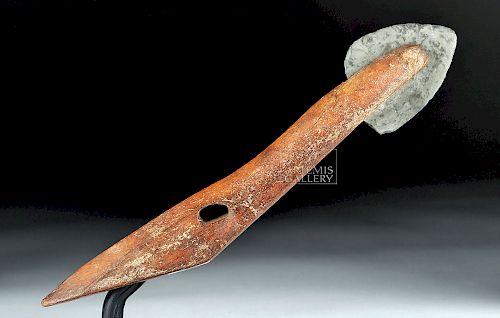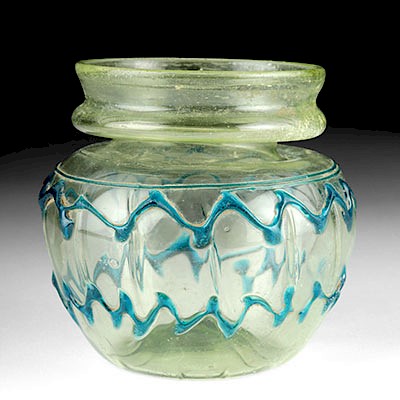Ancient Arctic Thule Bone Harpoon Foreshaft Slate Blade
Lot 193
About Seller
Artemis Fine Arts
686 S Taylor Ave, Ste 106
Louisville, CO 80027
United States
Selling antiquities, ancient and ethnographic art online since 1993, Artemis Gallery specializes in Classical Antiquities (Egyptian, Greek, Roman, Near Eastern), Asian, Pre-Columbian, African / Tribal / Oceanographic art. Our extensive inventory includes pottery, stone, metal, wood, glass and textil...Read more
Estimate:
$1,300 - $1,950
Absentee vs Live bid
Two ways to bid:
- Leave a max absentee bid and the platform will bid on your behalf up to your maximum bid during the live auction.
- Bid live during the auction and your bids will be submitted real-time to the auctioneer.
Bid Increments
| Price | Bid Increment |
|---|---|
| $0 | $25 |
| $300 | $50 |
| $1,000 | $100 |
| $2,000 | $250 |
| $5,000 | $500 |
| $10,000 | $1,000 |
| $20,000 | $2,500 |
| $50,000 | $5,000 |
| $100,000 | $10,000 |
| $200,000 | $20,000 |
About Auction
By Artemis Fine Arts
Aug 16, 2018
Set Reminder
2018-08-16 10:00:00
2018-08-16 10:00:00
America/New_York
Bidsquare
Bidsquare : Clearance Sale - Ancient / Ethnographic Art
https://www.bidsquare.com/auctions/artemis-gallery/clearance-sale---ancient-ethnographic-art-3368
These lots are going, going, gone... plus a nice selection of lots brand-new to auction! Artemis Fine Arts info@artemisgallery.com
These lots are going, going, gone... plus a nice selection of lots brand-new to auction! Artemis Fine Arts info@artemisgallery.com
- Lot Description
**Originally Listed At $700**
Native American, Arctic Region from Alaska to Greenland, Thule culture, ca. 1200 to 1700 CE. A fossilized bone harpoon point with a knapped slate blade. The bone is from a marine mammal, based on similar known examples. The bone handle is long, with a drilled hole where it widens. This created a socket, that allowed the harpoon to be rigid when thrown, and then bend when it hit prey. This was a crucial technological development on the part of the Thule, who subsisted on marine mammals. The slate blade is triangular and thin, set into a carved groove in the narrow end of the bone. This would have been used to hunt seals and walruses. Size: 5" W x 11.45" H (12.7 cm x 29.1 cm); 7.75" H (19.7 cm) on included custom stand.
The Thule people were the ancestors of modern Inuit whose advanced culture and technology made them a part of the global economy during what we in the west call the medieval period. This figure was carved during a dynamic time in Thule history; recent research indicates that sometime after ca. 1200 CE, perhaps in a span of just a few years, the Thule people spread from their Bering Strait homeland all the way to Greenland, likely driven by the search for iron, both from meteoric deposits they may have heard about from the Dorset people to their east and from trade. They traded with the Chinese to their west - metal beads and a belt buckle of Chinese manufacture and dating to 1100 to 1300 CE have been found in in the Seward Peninsula - and interacted with the Vikings to their east, who describe them in the Vinland Saga as the Skraelings.
Provenance: private Newport Beach, California, USA Collection
All items legal to buy/sell under U.S. Statute covering cultural patrimony Code 2600, CHAPTER 14, and are guaranteed to be as described or your money back.
A Certificate of Authenticity will accompany all winning bids.
We ship worldwide and handle all shipping in-house for your convenience.
#133583Fossilized bone has a crack near the split to attach the slate. Slate has small chips commensurate with age. Nice patina on the bone handle.Condition
- Shipping Info
-
All shipping is handled in-house for your convenience. Your invoice from Artemis Gallery will include shipping calculation instructions. If in doubt, please inquire BEFORE bidding for estimated shipping costs for individual items.
-
- Buyer's Premium



 EUR
EUR CAD
CAD AUD
AUD GBP
GBP MXN
MXN HKD
HKD CNY
CNY MYR
MYR SEK
SEK SGD
SGD CHF
CHF THB
THB
















